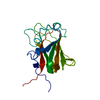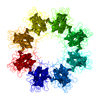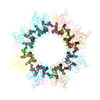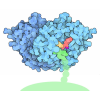[English] 日本語
 Yorodumi
Yorodumi- PDB-3jd6: Double octamer structure of retinoschisin, a cell-cell adhesion p... -
+ Open data
Open data
- Basic information
Basic information
| Entry | Database: PDB / ID: 3jd6 | ||||||
|---|---|---|---|---|---|---|---|
| Title | Double octamer structure of retinoschisin, a cell-cell adhesion protein of the retina | ||||||
 Components Components | Retinoschisin | ||||||
 Keywords Keywords | CELL ADHESION / discoidin domain / double octamer / adhesion protein / X-linked retinoschisis | ||||||
| Function / homology |  Function and homology information Function and homology informationneuron to neuron synapse / retina layer formation / eye development / phosphatidylinositol-3,4-bisphosphate binding / phosphatidylserine binding / photoreceptor inner segment / visual perception / protein homooligomerization / cell adhesion / external side of plasma membrane ...neuron to neuron synapse / retina layer formation / eye development / phosphatidylinositol-3,4-bisphosphate binding / phosphatidylserine binding / photoreceptor inner segment / visual perception / protein homooligomerization / cell adhesion / external side of plasma membrane / protein-containing complex binding / protein-containing complex / extracellular space Similarity search - Function | ||||||
| Biological species |  Homo sapiens (human) Homo sapiens (human) | ||||||
| Method | ELECTRON MICROSCOPY / single particle reconstruction / cryo EM / Resolution: 4.1 Å | ||||||
 Authors Authors | Tolun, G. / Vijayasarathy, C. / Huang, R. / Zeng, Y. / Li, Y. / Steven, A.C. / Sieving, P.A. / Heymann, J.B. | ||||||
 Citation Citation |  Journal: Proc Natl Acad Sci U S A / Year: 2016 Journal: Proc Natl Acad Sci U S A / Year: 2016Title: Paired octamer rings of retinoschisin suggest a junctional model for cell-cell adhesion in the retina. Authors: Gökhan Tolun / Camasamudram Vijayasarathy / Rick Huang / Yong Zeng / Yan Li / Alasdair C Steven / Paul A Sieving / J Bernard Heymann /  Abstract: Retinoschisin (RS1) is involved in cell-cell junctions in the retina, but is unique among known cell-adhesion proteins in that it is a soluble secreted protein. Loss-of-function mutations in RS1 lead ...Retinoschisin (RS1) is involved in cell-cell junctions in the retina, but is unique among known cell-adhesion proteins in that it is a soluble secreted protein. Loss-of-function mutations in RS1 lead to early vision impairment in young males, called X-linked retinoschisis. The disease is characterized by separation of inner retinal layers and disruption of synaptic signaling. Using cryo-electron microscopy, we report the structure at 4.1 Å, revealing double octamer rings not observed before. Each subunit is composed of a discoidin domain and a small N-terminal (RS1) domain. The RS1 domains occupy the centers of the rings, but are not required for ring formation and are less clearly defined, suggesting mobility. We determined the structure of the discoidin rings, consistent with known intramolecular and intermolecular disulfides. The interfaces internal to and between rings feature residues implicated in X-linked retinoschisis, indicating the importance of correct assembly. Based on this structure, we propose that RS1 couples neighboring membranes together through octamer-octamer contacts, perhaps modulated by interactions with other membrane components. | ||||||
| History |
|
- Structure visualization
Structure visualization
| Movie |
 Movie viewer Movie viewer |
|---|---|
| Structure viewer | Molecule:  Molmil Molmil Jmol/JSmol Jmol/JSmol |
- Downloads & links
Downloads & links
- Download
Download
| PDBx/mmCIF format |  3jd6.cif.gz 3jd6.cif.gz | 68.5 KB | Display |  PDBx/mmCIF format PDBx/mmCIF format |
|---|---|---|---|---|
| PDB format |  pdb3jd6.ent.gz pdb3jd6.ent.gz | 49.7 KB | Display |  PDB format PDB format |
| PDBx/mmJSON format |  3jd6.json.gz 3jd6.json.gz | Tree view |  PDBx/mmJSON format PDBx/mmJSON format | |
| Others |  Other downloads Other downloads |
-Validation report
| Summary document |  3jd6_validation.pdf.gz 3jd6_validation.pdf.gz | 925.5 KB | Display |  wwPDB validaton report wwPDB validaton report |
|---|---|---|---|---|
| Full document |  3jd6_full_validation.pdf.gz 3jd6_full_validation.pdf.gz | 925.6 KB | Display | |
| Data in XML |  3jd6_validation.xml.gz 3jd6_validation.xml.gz | 16.3 KB | Display | |
| Data in CIF |  3jd6_validation.cif.gz 3jd6_validation.cif.gz | 22.2 KB | Display | |
| Arichive directory |  https://data.pdbj.org/pub/pdb/validation_reports/jd/3jd6 https://data.pdbj.org/pub/pdb/validation_reports/jd/3jd6 ftp://data.pdbj.org/pub/pdb/validation_reports/jd/3jd6 ftp://data.pdbj.org/pub/pdb/validation_reports/jd/3jd6 | HTTPS FTP |
-Related structure data
| Related structure data |  6425MC M: map data used to model this data C: citing same article ( |
|---|---|
| Similar structure data |
- Links
Links
- Assembly
Assembly
| Deposited unit | 
|
|---|---|
| 1 | x 16
|
| 2 |
|
| 3 | 
|
| Symmetry | Point symmetry: (Schoenflies symbol: D8 (2x8 fold dihedral)) |
- Components
Components
| #1: Protein | Mass: 23889.830 Da / Num. of mol.: 1 / Fragment: UNP residues 24-224 Source method: isolated from a genetically manipulated source Source: (gene. exp.)  Homo sapiens (human) / Gene: RS1, XLRS1 / Plasmid: 11109-E01 / Production host: Homo sapiens (human) / Gene: RS1, XLRS1 / Plasmid: 11109-E01 / Production host:  |
|---|---|
| Has protein modification | Y |
-Experimental details
-Experiment
| Experiment | Method: ELECTRON MICROSCOPY |
|---|---|
| EM experiment | Aggregation state: PARTICLE / 3D reconstruction method: single particle reconstruction |
- Sample preparation
Sample preparation
| Component | Name: Purified Retinoschisin: residues 24-224 + 6xHis / Type: COMPLEX / Synonym: RS1 |
|---|---|
| Buffer solution | Name: 20 mM Tris-HCl, 150 mM NaCl / pH: 7.5 / Details: 20 mM Tris-HCl, 150 mM NaCl |
| Specimen | Conc.: 0.2 mg/ml / Embedding applied: NO / Shadowing applied: NO / Staining applied: NO / Vitrification applied: YES |
| Specimen support | Details: Plasma-cleaned 2.0 um hole, 2.0 um space C-flat holey carbon grids (Protochips) |
| Vitrification | Instrument: LEICA EM GP / Cryogen name: ETHANE / Humidity: 90 % Details: Ambient temperature 23 degrees C. Plunged into liquid ethane (LEICA EM GP). |
- Electron microscopy imaging
Electron microscopy imaging
| Experimental equipment |  Model: Tecnai Polara / Image courtesy: FEI Company |
|---|---|
| Microscopy | Model: FEI POLARA 300 / Date: Jun 3, 2014 / Details: 10 frames over 3 seconds |
| Electron gun | Electron source:  FIELD EMISSION GUN / Accelerating voltage: 300 kV / Illumination mode: FLOOD BEAM FIELD EMISSION GUN / Accelerating voltage: 300 kV / Illumination mode: FLOOD BEAM |
| Electron lens | Mode: BRIGHT FIELD / Nominal magnification: 39000 X / Cs: 2 mm |
| Specimen holder | Specimen holder model: OTHER / Specimen holder type: FEI Polara specimen loader |
| Image recording | Electron dose: 30 e/Å2 / Film or detector model: GATAN K2 (4k x 4k) / Details: Counting mode |
| Image scans | Num. digital images: 19 |
- Processing
Processing
| EM software |
| ||||||||||||||||||||||||
|---|---|---|---|---|---|---|---|---|---|---|---|---|---|---|---|---|---|---|---|---|---|---|---|---|---|
| CTF correction | Details: Included in iterative refinement | ||||||||||||||||||||||||
| Symmetry | Point symmetry: D8 (2x8 fold dihedral) | ||||||||||||||||||||||||
| 3D reconstruction | Method: Bayesian orientation refinement with iterative gridded reconstruction Resolution: 4.1 Å / Resolution method: FSC 0.143 CUT-OFF / Num. of particles: 9096 / Nominal pixel size: 1.03 Å / Actual pixel size: 1.03 Å / Symmetry type: POINT | ||||||||||||||||||||||||
| Atomic model building | Protocol: FLEXIBLE FIT / Space: REAL / Target criteria: FSC(0.5) = 4.7 Details: METHOD--Flexible fitting REFINEMENT PROTOCOL--FLEXIBLE | ||||||||||||||||||||||||
| Atomic model building | PDB-ID: 1SDD Accession code: 1SDD / Source name: PDB / Type: experimental model | ||||||||||||||||||||||||
| Refinement step | Cycle: LAST
|
 Movie
Movie Controller
Controller






 PDBj
PDBj


